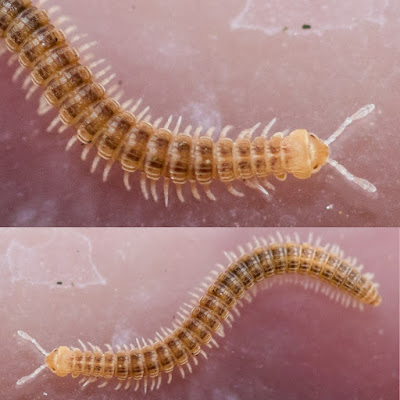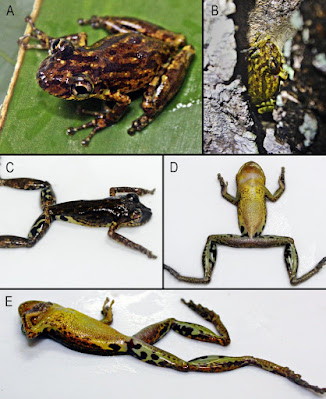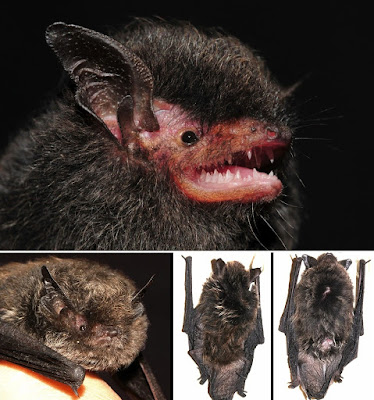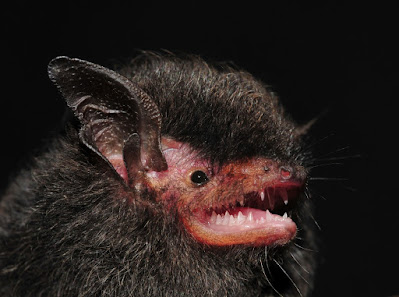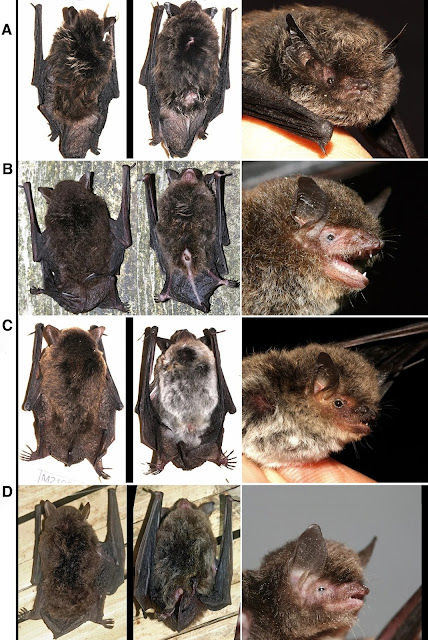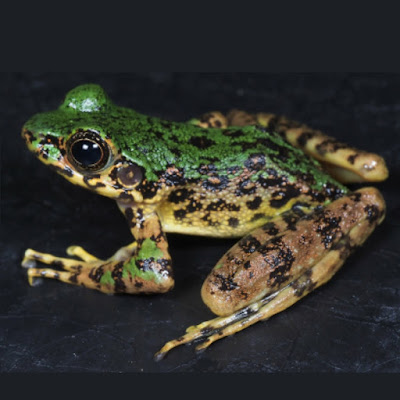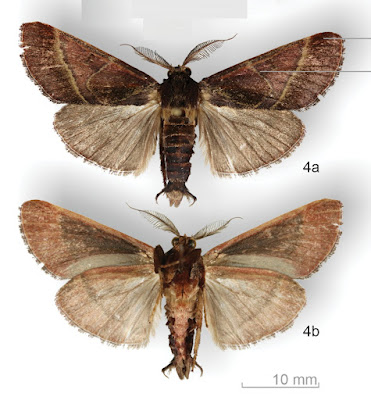[Most Recent Entries] [Calendar View]
Sunday, January 17th, 2021
| Time | Event | ||||||
| 8:19a | [Diplopoda • 2021] The Millipede Family Striariidae Bollman, 1893. II. New Records and Species of the Genus Amplaria Chamberlin, 1941 (Chordeumatida, Striarioidea)
Abstract The millipede genus Amplaria Chamberlin, 1941 (senior synonym of Vaferaria Causey, 1958 and Speostriaria Causey, 1960) is endemic to western North America, from Mt. Palomar and San Luis Obispo, California, north to southwestern British Columbia, Canada, and east to northern Idaho. Seven species names are currently assigned to the genus. Below I describe ten additional new species: Amplaria crawfordi, Amplaria fontinalis, Amplaria rykkenae, Amplaria arcata, Amplaria baughi, Amplaria staceyi, Amplaria umatilla, Amplaria cervus, Amplaria mendocino and Amplaria flucticulus, and provide new records of Amplaria nazinta Chamberlin. Keywords: Diplopoda, new species, Striaria, California, Oregon, Washington, troglobites Amplaria staceyi William A. Shear. 2021. The Millipede Family Striariidae Bollman, 1893. II. New Records and Species of the Genus Amplaria Chamberlin, 1941 (Diplopoda, Chordeumatida, Striarioidea). Zootaxa. 4908(2); 205–224. DOI: 10.11646/zootaxa.4908.2.3 | ||||||
| 8:29a | [Herpetology • 2021] Scinax tropicalia • A New Species of Scinax Wagler (Hylidae: Scinaxini) from the Tropical Forests of Northeastern Brazil
Abstract We describe a new species of the Scinax ruber clade from Northeastern Brazil that occurs in widely separated geographic areas in the Atlantic Forest of southern Bahia state and the Highland Humid Forest of Serra de Baturité, northeast Ceará state. Scinax tropicalia sp. nov. is diagnosed from all 75 currently recognize species of the S. ruber clade by bioacoustical and morphological adult traits, such as duration (0.11–0.31 s) and dominant frequency (1.59–1.85 kHz) of the advertisement call, snout shape rounded, nearly rounded, or semi-circular in dorsal view and rounded to slightly protruding in profile, bilobate vocal sac, absence of pectoral glands and spicule-shaped papillary epidermal projections on nuptial pads, and color pattern on the dorsum of body and hidden surfaces of hindlimbs. Keywords: Amphibia, Atlantic Forest, Bioacoustic, “Brejos de Altitude”, “Brejos Nordestinos”, Morphology, Northeastern Highlands, Taxonomy, Tropicália Scinax tropicalia sp. nov. Diagnosis. The new species is diagnosed by the following combination of characters: (1) male SVL 30.8–39.7 mm, n = 48; (2) snout rounded, nearly rounded, or semi-circular in dorsal view and rounded to slightly protruding in profile; (3) tympanum diameter about half size of eye diameter (TD/ED = 0.50 ± 0.054); (4) pointed tubercles on heel and lower jaw absent; (5) vocal sac bilobate, subgular; (6) slightly thick nuptial pad covering the Metacarpal II dorsomedially, and obscuring the outer margin of the thenar tubercle ventrally; (7) spicule-shaped papillary epidermal projections absent on the nuptial pad; (8) pectoral glands absent in males; (9) moderately developed pre- and postaxial webbing of Toe IV, reaching the proximal half of the penultimate phalanx; (10) dorsal pattern consisting of a brown background with two continuous or discontinuous longitudinal darker brown blotches, and an interocular marking; (11) in living specimens, color pattern of hidden surfaces of thighs, shanks, and tarsi consisting of medium to large size, rounded or irregular, dark brown blotches in a white, light blue, light green, light purple, or light yellowish-green background; (12) iris bronze with dark reticulations in living specimens; (13) physiological chlorosis absent; (14) advertisement call composed of a multipulsed note of duration 0.11–0.31 s, 8–20 pulses per note, pulse rate of 61–73 pulses/s, and dominant frequency of 1.59–1.85 kHz. Etymology. The specific epithet, a noun in apposition, is in allusion to the tropical habitat where the new species occurs, and also in homage to the Brazilian revolutionary artistic movement known as Tropicália, or Tropicalismo. This cultural movement arose in the late 1960s and had among its famous members the musicians from Bahia, Caetano Veloso, Gilberto Gil, Gal Costa, and Tom Zé, among other artists. The “tropicalists” introduced many aesthetical innovations and mixed a myriad of elements and rhythms from diverse origins (national and for-eign, traditional and avant-garde, popular and erudite). This movement was formally disintegrated in 1968 with the prison and exile of Caetano Veloso and Gilberto Gil by the authoritarian military dictatorship that ruled Brazil from 1964 to 1985. Tropicália certainly has marked and influenced the Brazilian popular culture over the years from its genesis. For more details about Tropicália, see Veloso & Dunn (1996), Favaretto (2000), Dunn (2001, 2014), Veloso (2017), and Oliveira (2020). Suggested common name. Tropicalia’s Snouted Treefrog. Gabriel Novaes-E-Fagundes, Katyuscia Araujo-Vieira, Omar M. Entiauspe-Neto, Igor J. Roberto, Victor G. D. Orrico, Mirco Solé, Célio F. B. Haddad and Daniel Loebmann. 2021. A New Species of Scinax Wagler (Hylidae: Scinaxini) from the Tropical Forests of Northeastern Brazil. Zootaxa. 4903(1); 1–41. DOI: 10.11646/zootaxa.4903.1.1 | ||||||
| 8:44a | [Mammalogy • 2021] Molecular and Morphological Revision of Small Myotinae from the Himalayas shed new light on the poorly Known Genus Submyotodon (Chiroptera: Vespertilionidae)
Abstract The systematics status of the constituent species of the M. mystacinus morphogroup in the Himalayan region has long been marred by uncertainty. Lack of integrative studies combining morphological and genetic data from specimens recently collected in this region has hampered our understanding of cryptic variations in this complex taxonomic group. To address this issue, new material from the Himalayan region of India and Nepal was obtained and vouchered specimens in the holdings of various museums were also re-examined. As comparative material, a large series of relevant specimens from South and Southeast Asia were also included in this revision. Using a combination of multivariate analysis of craniodental characters and molecular reconstructions, we critically evaluated the systematic position of the small Myotinae in the Himalayas. We establish that M. nipalensis forms a very distinct lineage (which also includes the recently described M. annatessae) and refute previous taxonomic suggestions that it is related to M. davidii. Our study also conclusively proved the common occurrence of the poorly known genus Submyotodon in the Himalayan region (Afghanistan, Pakistan, India, Nepal and China) and evidenced species-level divergences within that genus. Submyotodon species share nyctalodont or semi-nyctalodont lower molar configuration with few other small and unrelated Myotinae from Asia suggesting that these unusual dental characters are homoplasious in this subfamily. We also noticed a very confused taxonomic situation associated with many DNA sequences of Asian Myotis deposited in public repositories and call for possibilities of better data curation. Keywords: Myotis, muricola, Systematics, Barcode
Manuel Ruedi, Uttam Saikia, Adora Thabah, Tamás Görföl, Sanjan Thapa and Gábor Csorba. 2021. Molecular and Morphological Revision of Small Myotinae from the Himalayas shed new light on the poorly Known Genus Submyotodon (Chiroptera: Vespertilionidae). Mammalian Biology. DOI: 10.1007/s42991-020-00081-3 | ||||||
| 9:00a | [Herpetology • 2021] Odorrana dulongensis • A New Frog Species of the Genus Odorrana (Anura: Ranidae) from Yunnan, China
Abstract The Chinese-Myanmar border area forms part of a long-acknowledged biodiversity hotspot. This region is characterised by dramatic topography and diverse landscapes, which support a high degree of biodiversity and endemism that remains largely understudied. Based on recent survey efforts we here describe a new frog species of the genus Odorrana from this area. Found in Dulongjiang village, Yunnan, China, the new species differs from a morphological perspective from its congeners through the combination of a grass-green dorsum with black posterior spots, absence of dorsolateral folds, a distinct pineal body, presence of supratympanic folds, absence of outer metacarpal, metatarsal and supernumerary tubercles, and a pair of external subgular vocal sacs. From a molecular perspective, pairwise genetic distances of 4.8% to 11.6% for DNA sequences of the mitochondrial gene for 16S ribosomal RNA differentiate the new species from other Odorrana. Our mitochondrial phylogeny suggests that the new species is a deeply divergent genetic lineage clustering with the clade including Odorrana wuchuanensis, and the Odorrana andersonii and Odorrana margaretae groups. The discovery of this new species emphasizes the need for further herpetological studies in the China-Myanmar border region. Keywords: Amphibia, China-Myanmar border, Odorrana dulongensis sp. nov., taxonomy, Gaoligong, Dulongjiang Xiaolong Liu, Yanhong He, Yanfang Wang, Wouter Beukema, Shaobin Hou, Yingcun Li, Jing Che and Zhiyong Yuan. 2021. A New Frog Species of the Genus Odorrana (Anura: Ranidae) from Yunnan, China. Zootaxa. 4908(2); 263–275. DOI: 10.11646/zootaxa.4908.2.7 | ||||||
| 9:18a | [Entomology • 2020] Sacada chaehomensis • A New Species of Sacada Walker, 1862 (Lepidoptera, Pyralidae, Pyralinae) from northern Thailand
Abstract A new species of Sacada from northern Thailand is described: Sacada chaehomensis sp. nov. Pellinen & Zahiri (Lepidoptera: Pyralidae, Pyralinae). Morphological characters and DNA barcode data are provided for the new species, with a morphological comparison to S. dzonguensis and S. umtasorensis, and a DNA-barcode comparison to S. ragonotalis and S. albioculalis, respectively. After this addition, the current number of valid species in the genus Sacada is 43. Key Words: Species description, morphology, DNA barcoding, snout moth, integrative taxonomy Sacada chaehomensis Pellinen & Zahiri, sp. nov. Diagnosis: Sacada chaehomensis sp. nov. is morphologically similar to S. dzonguensis Singh, Kirti & Ranjan, 2020 and S. umtasorensis Singh, Kirti & Ranjan, 2020. Diagnostic male characters of these three species are indicated on Figs 2–7 (females of these three species are unknown). Forewing postmedial line is straight on costa and medial line is straight in S. chaehomensis sp. nov. (postmedial line curved and medial line angled in S. dzonguensis; postmedial line straight and medial line angled in S. umtasorensis). With regard to diagnostic male genitalia characters, see Figs 5–7. Etymology: The species is named after its type locality, Chae Hom, in Lampang province, Thailand. Biology: The single known male was collected in May 2020 at 340 m altitude; it was attracted to light in forest with diverse tree species, interspersed with small vegetable plantations (Fig. 9). Immature stages are unknown. Distribution: The only specimen was collected in Lampang (Chae Hom) in northern Thailand. Markku J. Pellinen, Reza Zahiri and Pasi Sihvonen. 2020. A New Species of Sacada Walker, 1862 from Thailand (Lepidoptera, Pyralidae, Pyralinae). Evolutionary Systematics. 4(2): 71-77. DOI: 10.3897/evolsyst.4.59893 |
| << Previous Day |
2021/01/17 [Calendar] |
Next Day >> |
